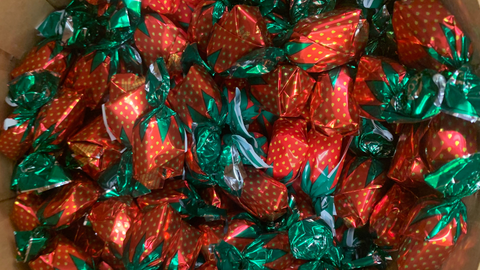The Ultimate Guide To I Luv Candi
The Ultimate Guide To I Luv Candi
Blog Article
Getting My I Luv Candi To Work
Table of ContentsIndicators on I Luv Candi You Need To KnowFacts About I Luv Candi RevealedThe Ultimate Guide To I Luv CandiOur I Luv Candi IdeasGetting My I Luv Candi To Work
You can likewise estimate your own profits by applying different assumptions with our financial prepare for a sweet-shop. Average monthly revenue: $2,000 This sort of sweet-shop is typically a little, family-run company, possibly understood to residents but not attracting lots of tourists or passersby. The shop could supply an option of typical candies and a couple of homemade deals with.
The store doesn't generally carry uncommon or pricey products, focusing instead on budget friendly deals with in order to preserve regular sales. Assuming an average investing of $5 per client and around 400 customers each month, the regular monthly income for this sweet-shop would be approximately. Ordinary monthly revenue: $20,000 This sweet-shop advantages from its strategic place in a busy city location, bring in a big number of customers seeking sweet indulgences as they shop.

In addition to its varied candy selection, this shop may also market associated products like present baskets, candy arrangements, and uniqueness items, giving numerous profits streams. The store's place requires a greater budget plan for rental fee and staffing however causes higher sales quantity. With an estimated typical spending of $10 per customer and concerning 2,000 customers each month, this store might generate.
Things about I Luv Candi
Situated in a significant city and visitor destination, it's a big establishment, typically spread out over multiple floors and potentially part of a national or worldwide chain. The shop supplies an immense range of candies, consisting of unique and limited-edition things, and merchandise like branded clothing and devices. It's not simply a store; it's a destination.
The operational costs for this type of shop are significant due to the place, size, personnel, and features offered. Assuming an ordinary acquisition of $20 per client and around 2,500 consumers per month, this front runner store could attain.
Group Instances of Expenses Ordinary Month-to-month Expense (Variety in $) Tips to Reduce Expenditures Lease and Utilities Store rent, electrical power, water, gas $1,500 - $3,500 Think about a smaller area, discuss lease, and use energy-efficient lights and home appliances. Inventory Sweet, snacks, product packaging products $2,000 - $5,000 Optimize stock management to minimize waste and track popular things to prevent overstocking.
Examine This Report about I Luv Candi
Advertising And Marketing Printed matter, on the internet advertisements, promotions $500 - $1,500 Concentrate on cost-effective digital advertising and marketing and utilize social networks systems for complimentary promo. Insurance Company responsibility insurance $100 - $300 Look around for competitive insurance policy prices and consider bundling policies. Devices and Upkeep Sales register, present shelves, repair work $200 - $600 Buy secondhand tools when feasible and execute regular maintenance to extend devices life expectancy.

This implies that the sweet-shop has actually gotten to a factor where it covers all its repaired costs and starts generating income, we call it the breakeven point. Consider an example of a sweet-shop where the month-to-month fixed costs generally amount to approximately $10,000. A harsh price quote for the breakeven factor of a sweet-shop, would certainly then be around (since it's the total set price to cover), or marketing in between with a cost series of $2 to $3.33 each.
The Main Principles Of I Luv Candi
A big, well-located candy store would clearly have a higher breakeven point than a tiny store that doesn't need much earnings to cover their expenses. Interested concerning the success of your sweet shop?
Another danger is competitors from other sweet-shop or larger stores that could offer a broader variety of products at reduced rates (https://cutt.ly/Xw3y4epn). Seasonal changes popular, like a drop in sales after vacations, can also influence profitability. In addition, transforming consumer choices for healthier treats or dietary limitations can lower the appeal of standard sweets
Financial declines that reduce consumer costs can influence sweet store sales and earnings, making it vital for candy stores to manage their costs and adapt to altering market problems to remain profitable. These risks are commonly consisted of in the SWOT evaluation for a sweet shop. Gross margins and internet margins are key signs utilized to assess the productivity of a sweet-shop business.
The Best Guide To I Luv Candi
Basically, it's the profit remaining after subtracting costs straight related to the candy inventory, such as acquisition costs from distributors, production prices (if the candies are homemade), and staff wages for those included in production or sales. https://disqus.com/by/carollunceford/about/. Web margin, on the other hand, factors in all the expenditures the sweet-shop sustains, consisting of indirect expenses like management expenses, marketing, rental fee, and taxes
Sweet-shop normally have a typical gross margin.For instance, if your sweet store earns $15,000 each month, your gross revenue would be about 60% x $15,000 = $9,000. Let's illustrate this with an instance. Think about a sweet store that sold 1,000 sweet bars, with each bar priced at $2, making look at here now the complete income $2,000 - da bomb. The store sustains costs such as buying the sweets, utilities, and wages for sales staff.
Report this page